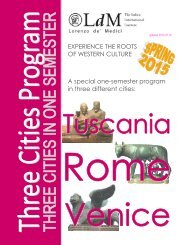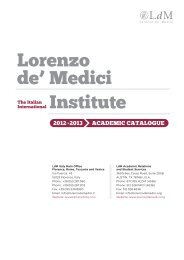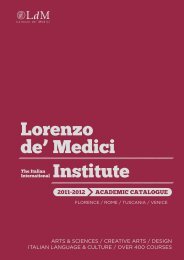aCademiC Catalog 2013-2014 - Lorenzo de Medici
aCademiC Catalog 2013-2014 - Lorenzo de Medici
aCademiC Catalog 2013-2014 - Lorenzo de Medici
Create successful ePaper yourself
Turn your PDF publications into a flip-book with our unique Google optimized e-Paper software.
School of Arts & Sciences TUSCANIA<br />
mainly on historical data and information, aims to provi<strong>de</strong> a<br />
general background about Italian politics and culture. In the<br />
second part, we will focus on the current changes that have<br />
occurred in Italy during the past 20 years, focusing especially<br />
on the breakdown of the traditional political system and on the<br />
<strong>de</strong>creased relevance of the Church in State and public matters.<br />
Finally, we will examine how the last 10 years – during which<br />
there has been a great transformation in the way media affects<br />
the distribution and spread of information – have brought an<br />
apparent, but possibly not real, upheaval in the way politics,<br />
culture and information are received and <strong>de</strong>bated among<br />
Italians.<br />
Prerequisites: an introductory course in History or Political<br />
Science<br />
Italian Renaissance Civilization and Culture<br />
HIS 300 T<br />
Cr: 3; Contact hrs: 45<br />
This course explores the historical, literary and cultural<br />
<strong>de</strong>velopments of one of the most remarkable and vibrant<br />
periods of Italian history: the Renaissance. Stu<strong>de</strong>nts will<br />
be introduced to the main historical <strong>de</strong>velopments of the<br />
Renaissance period from the late fourteenth century to the end<br />
of the sixteenth century. The Renaissance is above all the age<br />
of the individual and the affirmation of his/her achievements,<br />
best summed up by the credo “Man – the measure of all things”.<br />
The focus of this course is therefore upon great personalities<br />
of the Italian Renaissance mainly in the fields of the visual arts,<br />
literature and philosophy, but also drawn from those of politics<br />
and civic life. These inclu<strong>de</strong> key figures of the most prominent<br />
Italian families: the <strong>Medici</strong>, the Sforza, the Della Rovere; artists<br />
and architects: Brunelleschi, Leon Battista Alberti, Leonardo<br />
da Vinci, Michelangelo; writers, poets and philosophers: Dante,<br />
Petrarca, Boccaccio, Pico <strong>de</strong>lla Mirandola, Machiavelli, as well as<br />
merchants and bankers. All these individuals left their mark in<br />
Italy between the early 1400s and the late 1500s.<br />
Prerequisites: HIS 130 Western Civilization, or equivalent<br />
Literature<br />
Survey of Western Literature<br />
LIT 150 T<br />
Cr: 3; Contact hrs: 45<br />
This course is an exploration of major texts from antiquity to<br />
the present that have shaped and expressed Western cultural<br />
traditions (all readings are in English translation). Emphasis<br />
will be placed on the nature of genre, period, and style. The<br />
course also offers the opportunity to <strong>de</strong>velop an awareness of<br />
literature and the skills required to approach and un<strong>de</strong>rstand it.<br />
Italian Theatre from Arena to Opera<br />
LIT 278 T; Dual listed: MCT 278 T<br />
Cr: 3; Contact hrs: 45<br />
This course is an introduction to the history of theatre and<br />
performing arts in Italy from antiquity to the 20th Century.<br />
Stu<strong>de</strong>nts will study Greek and Roman tragedies and comedies<br />
and the sports and the games so popular in antiquity. They<br />
will then explore the <strong>de</strong>velopment of medieval sacred<br />
representations; the Commedia <strong>de</strong>ll’Arte; the total performances<br />
of the Renaissance and Baroque periods and their ultimate<br />
culmination in Italian opera; works by Goldoni; Piran<strong>de</strong>llo and<br />
Italian Futurism. Translated texts of all authors studied will be<br />
required reading in class or as homework, and original versions<br />
of some of the above-mentioned texts will be read in class.<br />
Discussions will be based on the stu<strong>de</strong>nts’ readings.<br />
The Age of the Heroes: Iliad, Odyssey, Aeneid,<br />
and the Origins of Western Literature<br />
LIT 306 T; Dual listed: CLA 306 T<br />
Cr: 3; Contact hrs: 45<br />
The course is a general overview of ancient literature through<br />
the analysis and comparison of some of the ol<strong>de</strong>st works of<br />
Western civilization. Through a reading of the most significant<br />
chapters of the Iliad and the Odyssey, stu<strong>de</strong>nts will get in<br />
contact with the aristocratic world and heroes <strong>de</strong>scribed by<br />
Homer in 8-7th century BCE, in or<strong>de</strong>r to reconstruct the society<br />
of early Greece in the Mycenaean period. The stories presented<br />
in the Iliad and Odyssey, consi<strong>de</strong>red the “Bible” of classical<br />
civilization, show how Greeks used myth to express archetypal<br />
values which became immortal for successive generations.<br />
Myths are analyzed not only as amazing stories but also as<br />
bearers of important messages about life within society, and<br />
as primary forms of communication and instruction in a nonliterate<br />
and oral society. The great influence of Greek myths on<br />
Roman legends will also be seen through the reading of some<br />
passages of the Aeneid - the national poem of Rome written<br />
by Virgil in the 1st century BCE - focusing on the link between<br />
Roman history and Greek tradition. The hero of the work,<br />
Aeneas, was the survivor of the fall of Troy and the ancestor of<br />
Rome’s lea<strong>de</strong>rs. A comparison between Aeneas’ and Odysseus’<br />
wan<strong>de</strong>rings will conclu<strong>de</strong> the course.<br />
Masterpieces of Italian Literature<br />
LIT 307 T<br />
Cr: 3; Contact hrs: 45<br />
The focus of this course is on Italian writers and literary<br />
movements from the 13th century to the present. Its goal is<br />
to read some of Italy’s most representative literary works in<br />
translation and to examine their structure, novelty and relevance<br />
to their times, and to our own times as well. This course is<br />
<strong>de</strong>signed to bring works of Italian literature to the attention<br />
of stu<strong>de</strong>nts who may have or may not have any knowledge<br />
of Italian. Topics will be introduced, followed by readings to<br />
be commented on by the stu<strong>de</strong>nts. Each stu<strong>de</strong>nt will also be<br />
required to <strong>de</strong>velop an individually chosen project based on a<br />
complete translated work. At the end of the term, each stu<strong>de</strong>nt<br />
will be required to write a paper on a chosen text and then give<br />
a presentation in class about his/her own work.<br />
Prerequisites: LIT 150 Survey of Western Literature, or<br />
equivalent<br />
Italian Grand Tour: Italy through the Eyes of<br />
Famous Travellers<br />
LIT 350 T<br />
Cr: 3; Contact hrs: 45<br />
This course is an introduction to the literature generated by<br />
the «Grand Tour» experiences between the 18th and the 19th<br />
centuries and to its continuation and <strong>de</strong>velopment in the<br />
20th century. The main focus will be the textual analysis of<br />
the memoirs, letters and diaries written by some of the most<br />
famous artists, writers and intellectuals who resi<strong>de</strong>d and<br />
traveled in Italy. Our selection will inclu<strong>de</strong> British, German and<br />
American writers. Another important aspect of the course will<br />
be the study of the history, the works of art, the monuments<br />
and the folklore events of the main Grand Tour <strong>de</strong>stinations:<br />
Venice, Florence, Rome. Stu<strong>de</strong>nts will learn about the different<br />
experiences of famous foreign travelers in Italy through the<br />
centuries and will be able to un<strong>de</strong>rstand some stereotypes,<br />
prejudices and i<strong>de</strong>alized visions about Italy and Italians that still<br />
survive today.<br />
Music, Cinema and Theatre<br />
Studies<br />
Introduction to Acting<br />
MCT 205 T<br />
Cr: 3; Contact hrs: 60<br />
The course will center on three fundamental aspects of acting:<br />
imagination, sensuousness and physicality. In fact, the base of<br />
an actor’s initiation consists of the exploration of the world<br />
around him and the <strong>de</strong>velopment of the five senses (plus the socalled<br />
sixth sense which has more to do with our own instincts).<br />
An actor must be able to transmit emotionally what nature<br />
gives her or him. So, work in this course will focus on: a) the<br />
awareness of the body and moving with greater physical ease<br />
by the un<strong>de</strong>rstanding of how the five senses work together;<br />
b) the creation of a bridge between body and imagination; c)<br />
activating the senses through a series of games and exercises;<br />
d) script analysis in or<strong>de</strong>r to un<strong>de</strong>rstand the message or<br />
meaning and to find the super-objective of the play. Stu<strong>de</strong>nts<br />
will work on relaxation techniques, on their sensuousness and<br />
its application to their creative instinct; on their concentration<br />
162<br />
LdM Aca<strong>de</strong>mic <strong>Catalog</strong> <strong>2013</strong>-<strong>2014</strong>





